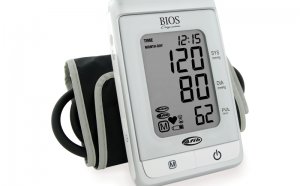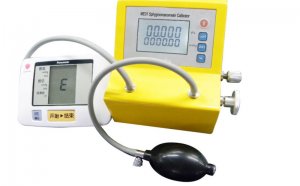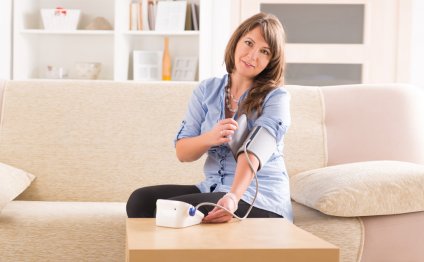
Blood pressure indicator
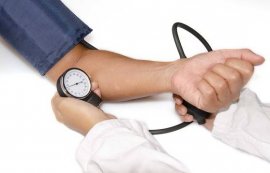 Blood pressure is the measure of the force of blood pushing against blood vessel walls. A normal value is 120/80 mmHg or lower.
Blood pressure is the measure of the force of blood pushing against blood vessel walls. A normal value is 120/80 mmHg or lower.
A beating heart creates the pressure when it pumps fresh blood to the organs and tissues of your body, providing oxygen and nutrients.
Blood Pressure & Heart Rate Assessment tool
Navigation: (BP stands for blood pressure):
Blood pressure basics:
Causes and prevention::
Symptoms::
Measurement::
Treatment::
Keywords: blood pressure, pulse, hypotension, hypertension, good or bad blood pressure levels, normal blood pressure, blood pressure over heart rate, sys, dia
With a healthy lifestyle you can do a lot for your health, starting today!
The BP (short for Blood Pressure) value does not only depend on lifestyle, but also on factors which can not be influenced – for example your genetics. or arterial hypertension is a very common chronic disease in the developed world, affecting nearly every second adult.
While very often elevated blood pressure shows no symptoms, it still causes damage to your arteries (atherosclerosis) and weakens your heart. That is why it is sometimes referred to as the “silent killer”. To prevent this you must necessarily undergo a treatment.
Blood pressure is the pressure with which blood acts against the walls of your blood vessels. A beating heart creates pressure when it pumps fresh blood to the organs and tissues of your body, providing oxygen and nutrients.
A healthy adults heart beats (shrinks and expands) between 60 to 70 times in a minute. If your heart rate (heart pulse) is higher or lower anytime, that does not necessarily mean you have a medical condition.
Since elevated blood pressure does not “hurt” and usually does not cause any visible changes it can only be determined by measurement.
Image source: huffingtonpost.com
When we refer to blood pressure we always refer to two numbers in following format: 120/80, 100/60 or similar. The first number stands for systolic blood pressure, the second number stands for diastolic blood pressure.
When the heart shrinks and pushes the blood into main arteries (aortas), blood pressure rises for a moment – this is known as systolic blood pressure (sys blood pressure).
After each shrinkage the heart expands again and is filled with new blood – at that moment blood pressure in the arteries drops for a moment – this is known as (dia blood pressure).
Blood pressure can either be normal, low or high. If it is elevated, you must seek medical advice. If it is low, seek medical advice only if you develop symptoms, described below. High blood pressure is anything above 140/90 mmGh. Low blood pressure is anything below 110/70 mmGh.
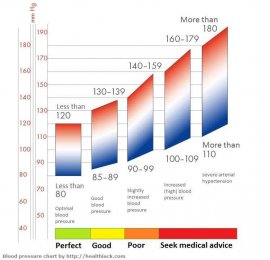 Normal blood pressure for a healthy individual is between 120/80 and 139/89 mmGh. Although 139/89 mmGh is the upper limit and is considered borderline good blood pressure, it still may be treated as normal.
Normal blood pressure for a healthy individual is between 120/80 and 139/89 mmGh. Although 139/89 mmGh is the upper limit and is considered borderline good blood pressure, it still may be treated as normal.
Average blood pressure is between 120/80 and 125/85 mmGh. Ideal blood pressure is below 120/80 mmHg.
For more information refer to .
Normal blood pressure value is 120/80 mmGh, preferably less.
High blood pressure is anything above 140/90 mmGh.
Low blood pressure is anything below 110/70 mmGh.
The reason for permanent increase in blood pressure in majority of cases (more than 95%) is not known – this is primary or essential arterial hypertension. Factors that may increase the possibility of you developing arterial hypertension are usually the following:
- poor diet with excessive use of salt,
- obesity,
- excessive alcohol consumption (more than 10 ounces (3 dcl) of wine or 3 ounces (1 dcl) spirits or 2 small beers every day),
- physical inactivity.
By changing your lifestyle you can easily and naturally mitigate the risk.
There are also factor on which you have no influence, but may cause your blood pressure to rise / drop. Causes of high blood pressure are:
- inherited characteristics (genetics),
- gender (male),
- aging (after the age of 45, it gradually rises).
The risk increases linearly with the increase of blood pressure. The more it is increased, the greater the risk. People with high blood pressure are at seven times higher risk for stroke.
Numerous studies have shown that successful treatment of high blood pressure decreases the risk of cardiovascular disease and lowers mortality, thus, it is very important that you undergo a treatment when you are diagnosed with high blood pressure.
People with high blood pressure are at seven times higher risk for stroke.
Sometimes your blood pressure might be too low which may induce symptoms such as tiredness in the morning, lack of energy throughout the day, dizziness and sleepiness, headache, drowsiness, nausea, lack of appetite, cold hands and feet or even fainting (which can be dangerous, especially to pregnant women and the elderly).
RELATED VIDEO


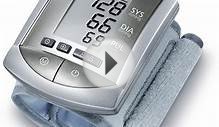
Share this Post
Related posts
Blood Pressure Monitor
BIOS Medical - ULTRA BLOOD PRESSURE MONITOR WITH ATRIAL
Read MoreBlood pressure calibration
Highlights • A Hammerstein–Windkessel model to represent the central blood pressure system. • A Kalman filter estimated the…
Read More
